 |
The different facets of karst and caves
Take a virtual journey from the surface of karst landscapes, into the twilight zone behind the cave entrance, to the zone of eternal darkness deep in the caves, with passages of all kind of shapes. Appreciate the diversity of this underground realm and the elements that shape the rich spectrum of karst phenomena. Your journey finishes with weird, cave-dwelling fauna – including the human species. |
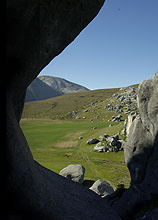 |
 |
Karst landscapes
Karst is the general term for landscapes with fractured and soluble rock in the subsurface, shaped by dissolution, such as limestone, dolomite, gypsum, etc. Water dissolves the rock and makes underground drainage pathways which give it a shortcut, by gravity alone, down to sea level. The geomorphological shapes this creates include a wide diversity of karren – grooves and fissures – most visible where the soil has been eroded and the bedrock lies exposed. Most conspicuous among surface karst features are large dissolution landforms, such as dolines, rock shelters, and natural bridges – and, of course, cave entrances.
to the photo gallery Daylight |
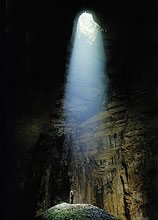 |
 |
Twilight zone in cave entrances
In the entrance to a cave, daylight penetrates from outside and blends with the absolute darkness inside. In this twilight zone, we experience a transition from the familiar world above ground, with weather phenomena, a diurnal rhythm, colours, odours, sounds, and the obligatory dose of stress and sorrow, into a completely different world with unique laws governed by rock and water. Our mode of movement and the perception of our surroundings change markedly as soon as we venture into this underground realm ...
to the photo gallery Twilight |
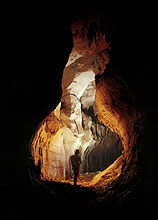 |
 |
Cave passages in profile
The inner architecture of natural caves is diverse and ranges from large river caves and chessboard-like fissure labyrinths, to sponge-like three-dimensional mazes. We encounter circular tubes, high fissures, sharply corroded corners, tight squeezes, cathedral-style chambers and spacious vaults with scoured ceilings. The specific shapes of the passages are the foundation of the unique character of each cave.
to the photo gallery Passages |
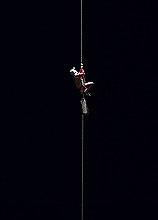 |
 |
Pits and shafts – when caves turn vertical
When being formed, caves do not care whether passages allow us humans a comfortable, horizontal mode of locomotion. Quite often, water prefers a vertical dimension. The result is a pits or shafts, in which the caver uses ropes to rappel "like a spider on its silky thread" – the most commonly applied metaphor in this field. Aided by modern static ropes and special abseiling and climbing devices, cavers have explored vertical caves of up to more than 2,000 metres in depth, and single drops of more than 500 metres.
to the photo gallery Shafts |
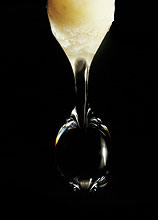 |
 |
No water – no caves
Water is the life essence of caves. Not only is it responsible for the very formation of caves by dissolving the bedrock and transporting it away, but it also allows for the dissolved minerals to crystallise elsewhere in the cave and form delicate speleothems. We encounter water in the raging underground torrents, roaring waterfalls, small droplets on the tips of soda straw stalactites, or in quiet basins and lakes. Water is also the element that introduces both acoustics and movement into the otherwise silent and static realm of rock.
to the photo gallery Water |
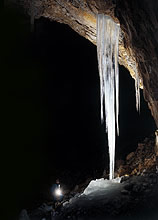 |
 |
Ice caves and ice in caves
Ice is a mineral – the solid phase of hydrogen oxide which, below 0 °C, takes on a crystalline structure. In cold cave environments, water may form dripstone formations – such as stalagmites, stalactites, draperies and even helictites – reminiscent of those formed from dissolved calcium carbonate. During cold winter spells, we can observe time-lapse dripstone formation in cave entrances. A transient decoration – vanishing as soon as temperatures rise again. In alpine caves, where temperatures are permanently below freezing, ice can build up huge domes and frozen cascades. Some caves are formed by meltwater run-off in glaciers. These ice caves also change their appearance significantly, depending on the season and faced with ongoing global warming.
to the photo gallery Ice |
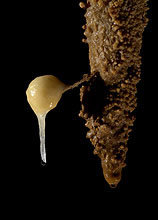 |
 |
Calcite speleothems
When the limestone in karst areas is being dissolved by acidic rainwater, dissolved carbonate species are the basis for the formation of diverse dripstone formations (speleothems). The carbonate mineral calcite has the highest number of known crystal shapes of any mineral. This is multiplied by the numerous types of different speleothems calcite may form, including not only the classical stalagmites and stalactites, but also so-called soda straws, popcorn, canopies, shower heads, bottle brushes, draperies, dogtooth spar and the fascinating helictites – weird calcite formations which defy gravity when strong surface tension and capillary force come into play.
to the photo gallery Calcite |
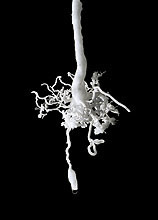 |
 |
Aragonite speleothems
Aragonite is the rare sibling of calcite. It has the same chemical composition but is made up of a different crystal lattice. With regard to morphological creativity, aragonite can most aptly be described as "totally screwed". The often pure-white aragonite forms bizarre helictites or needle aggregates. Why we find aragonite in caves is somewhat of a mystery because its crystal lattice is metastable at the prevailing temperature and pressure conditions. Key to the understanding of aragonite precipitation is the load of magnesium in the water, because high concentrations of magnesium prohibit precipitation of calcite and instead promote the formation of aragonite.
to the photo gallery Aragonite |
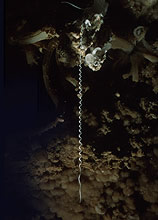 |
 |
Gypsum speleothems
Apart from the calcium carbonates calcite and aragonite, gypsum is the most common cave mineral. This applies, in particular, to caves that have formed through sulphuric acid speleogenesis, which takes place where hydrogen sulphide emerging from hydrocarbon reservoirs makes contact with groundwater rich in oxygen. When sulphuric acid dissolves limestone, gypsum precipitates and then starts to form crusts, flowers, crystals and, in extreme cases, weird speleothems such as long and regular spirals.
to the photo gallery Gypsum |
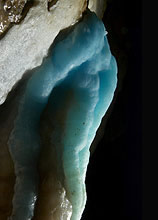 |
 |
Colourful speleothems
The colour palette used during the formation of speleothems is usually restricted to shades of brown, yellow, red and white. However, as soon as certain trace elements, such as copper, zinc, or iron, come into play, we may encounter a much more colourful display, in pure moss-green or deep blue. This can happen, for instance, where the limestone of the karst area comes into contact with crystalline rocks, or when ore deposits are present in the limestone beds. Unfortunately, such colourful speleothems are a rarity!
to the photo gallery Colour |
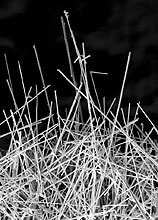 |
 |
Scanning electron microscopy of speleothems
With the scanning electron microscope (SEM), we can visualise a micro-world beyond the scale of familiar dimensions. Apparently unexciting speleothems, such as a mould-like coating on a cave wall, all of a sudden exhibit their true nature: in this case, the "mould" turns out to be composed of myriads of thin calcite needles, only few thousandths of a millimetre in diameter.
to the photo gallery SEM |
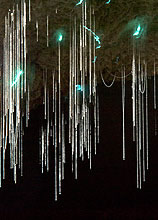 |
 |
Underground life
The obligatory bats are by no means the only life forms that dare to enter caves. The discipline of biospeleology has recorded a wide spectrum of cave dwellers, ranging from microbial biofilms found on almost every cave wall, and plate-sized cave spiders, to bizarre creatures like the olm or glowworms. The latter are the bioluminescent larvae of a fungus gnat endemic to New Zealand, and turn the ceiling of river caves into a night sky with myriads of stars.
to the photo gallery Troglobionts |
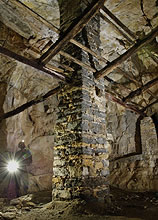 |
 |
Mankind and caves
Since the dawn of mankind, caves have held a prominent place in our cultures and religions. Caves are regarded as the home of gods, abysses inhabited by monsters, the realm of the undead, and art galleries. Or they serve a more pragmatic purpose, such as a warm place to hide during wintertime or as a humid cavern for ageing fine wine and cheese.
to the photo gallery Humans |
|
Assistance during photo sessions for these galleries:
Andy Armstrong, Hazel Barton, Stefanie Baumgärtner, Serge Delpech, Günther Forstmair, Jens Freigang, Peter Gedei, Oliver Gerstenberger, Norbert Häussermann, Jörg Haußmann, Artur Hofmann, James Hunter, Christine and Herbert Jantschke, Leo Klimmer, Christian Klug, Angela and Stephan Lang, Achim Lehmkuhl, Vivian Loftin, Matthias López Correa, Gaspard Magarinos, Peter Otto, Serge Nurit, Michel Renda, Dion Richards, Jens Römer, Phill Round, Dominik Ruepp, Patricia Seiser, Andrew Smith, Nick Smith, Uta Sternbach, Rainer Straub, Leo Viersma, Werner Vogel, Peter Wisshak, Stefanie Wisshak, Elisabeth Wolf, Dawn Wood
Million thanks! |
|






























